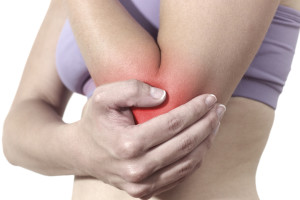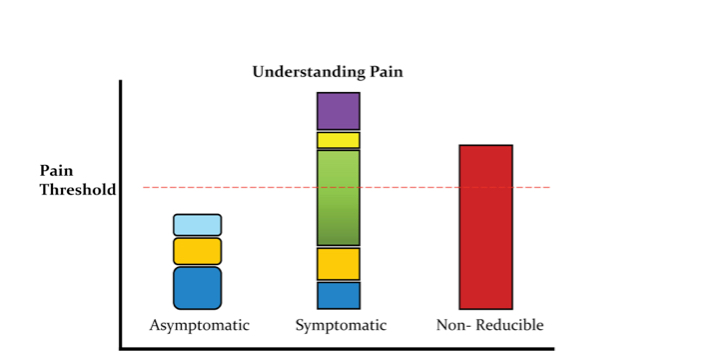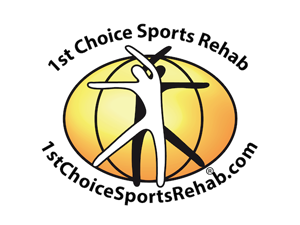Conquering Pain
by Dr. Niklaus DelFavero
Fast Relief Is Just Half the Story
 Pain is the primary reason patients come see us. Though no one likes to be in pain, it is an important way for our bodies to let us know something is not working right. The pain we see most frequently in the office could be classified as the result of Repetitive Stress Injuries (RSI). RSI injuries occur as a result of the same movements over long periods of time, such as running, playing tennis, or typing on a keyboard multiple hours per day. In this article we are going to discuss various ways of treating pain with the intention of showing that some ways of treating pain are better than others.
Pain is the primary reason patients come see us. Though no one likes to be in pain, it is an important way for our bodies to let us know something is not working right. The pain we see most frequently in the office could be classified as the result of Repetitive Stress Injuries (RSI). RSI injuries occur as a result of the same movements over long periods of time, such as running, playing tennis, or typing on a keyboard multiple hours per day. In this article we are going to discuss various ways of treating pain with the intention of showing that some ways of treating pain are better than others.
Choices for Pain Treatment – Is There a Difference?
There are many ways of treating pain. Over the years I have read numerous studies that compared the treatment of Low Back Pain with NSAIDS, rest, chiropractic or physical therapy. The studies reported little difference in the reduction of pain and rated them equally effective. I found these conclusions disturbing, so I examined the data closer and discovered some very interesting facts that confirmed what I had observed during years of clinical experience.
These studies based their findings exclusively on the Reduction of Pain. When the treatments were compared to each other, there was similar pain relief regardless of the method of care. However, what the studies failed to address was how likely the symptoms were to return.
A better way to measure the effectiveness of treatment would be to also consider how long relief lasts. In our office, the goal is to get our patients out of pain in the shortest time possible and help them stay pain free, even when they are active, so they don’t need to keep coming back to feel good.
How Pain Works
The graphic below may help to explain just how pain works. The horizontal dotted line represents the pain threshold. Below the dotted line, we don’t feel pain – above it – we do.

Our bodies are constantly adapting to dysfunction and our environment to minimize pain.
There may be potential causes of pain present, ie. improper movement patterns, muscle weakness, arthritis, or bulging disks. But if we remain below the threshold, we don’t feel pain. This is indicated by the first column. Hidden problems may be present but no pain is felt.
By comparison, the red column demonstrates a situation that is not treatable and will remain above the line regardless. In this circumstance, medication or surgery may be the only viable option.
The second column represents how most of us experience pain. Life events and the factors
mentioned above stack up like these colored blocks until we cross the pain threshold and “feel the pain.” The typical response is to take steps to remove or address one or more of these factors until we dip below the threshold and no longer experience pain. We may think the problem is fixed, but with hidden dysfunction still present, it will take very little to push us above the threshold again.
This explains why we see patients all the time that say, “All I did was bend over and pick up the newspaper, and I threw my back out. Now I can’t move!” The reality is there were underlying conditions that were not yet painful, but once the person bent forward something put them over the pain threshold. Now they are experiencing pain.
The studies I mentioned stated that medication, rest, chiropractic or PT may have the same effectiveness in treating pain. Taking NSAIDS alone might be enough to put you below the pain threshold. Resting without irritating the back might also drop you below the pain threshold. The same holds true for Chiropractic or physical therapy. But if the only gauge is pain, and if treatment stops when the pain disappears, the underlying problem may still be present. At that point, something as innocent as picking up the newspaper might be enough to cause the pain to return.
A Different Approach
Our team at 1st Choice Sports Rehab uses a different approach to managing pain. We evaluate the underlying causes of pain and address multiple factors in order to clear these dysfunctions. We don’t quit when you merely dip below the pain threshold. We continue to pursue the underlying issues until they are resolved. Using this protocol, pain is less likely to recur when you return to your marathon training, cross-fit workout, or activities of daily living.
If you are experiencing recurrent pain give us a call. The sports chiropractors and physical therapists at 1st Choice are mindful of the factors that can perpetuate your pain, and we are trained to eliminate them. By identifying and correcting these problems, we can help you have a better outcome and stay pain free.

Dr. Niklaus DelFavero, the owner of 1st Choice Sports Rehab Center, is a former collegiate and internationally competitive swimmer. He enjoys helping athletes overcome the injuries that can occur when striving for ever higher levels of performance. There are two office locations: Decatur and Johns Creek. To schedule an evaluation for either office, simply call 404-377-0011. If you have other questions or concerns, you may click here to email Dr. DelFavero directly.
Decatur Office
2545 Lawrenceville Hwy
Suite 100
Decatur, GA 30033
404-377-0011
fax 770-939-9353
Johns Creek Office
9810-B Medlock Bridge Rd
Suite 104
Johns Creek, GA 30097
404-300-9931
fax 770-939-9353
